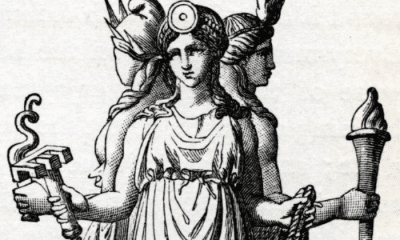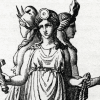Greek
Where Was Mount Olympus in Greek Mythology?
Mount Olympus was famous as the home of the gods, but where was this legendary place? Keep reading to find out!
In Greek mythology, the gods lived on the highest peak of Mount Olympus.
Their beautiful palaces were detailed by many writers. They held feasts in golden halls and hosted the full assembly of all the deities in a great courtyard in Zeus’s residence.
By most accounts, the home of the gods was similar to the palaces of Greece’s wealthy rulers. They lived in luxury but still had practical considerations like stables, a forge, and storage rooms.
The gods had a comfortable home on Mount Olympus, but where exactly was their home?
The answer to this question depends largely on which sources you consult. While some Greeks believed that Mount Olympus was relatively close to their own cities, others believed that it was another realm entirely.
Mount Olympus on Earth
Mount Olympus was not only the home of the gods. It was also a real place in Greece.
Olympus is the largest mountain in the modern country of Greece. It is located in a mountain range of the same name that runs along the border of the Greek region of Thessaly and the country of Macedonia.
Mount Olympus is considered to be a single mountain, but it has over fifty individual peaks.
The Greek gods were said to have made their home on the highest of these, Mytikas. At over 2,900 meters (over 9,500 feet) tall, Mytikas is one of the tallest peaks on the continent of Europe.
Some sources claimed that the gods had palaces spread across the peaks of Olympus. The highest place was reserved only for Zeus, who kept his throne there.
As the highest mountain in the region, Olympus seemed to be a logical home for the remote gods of the Greek pantheon. From there, they could see the world of men but were almost entirely inaccessible to mortals.
The ancient view of Mount Olympus was of an acropolis on a grand scale.
When the Acropolis of Athens is known for its temple complexes, the first such sites served a more practical purpose. They were fortified hilltops that protected the people of early Greece and their supplies from attack.
Even when the Acropolis of Athens and other cities came to be associated more with rituals than fortification, they still served as places of refuge during a crisis. Stores of food were kept in temples and fresh water was available from wells and springs.
While the acropolis was no longer necessarily fortified, it was considered a place of safety. The temples built there offered protection because no Greek person would dare to commit murder inside the sacred space of the gods.
Mount Olympus was the paradigm of this sacred space.
The golden palaces of the gods were the models for their temples on earth. While some sources claimed that Olympus was protected by golden gates, its real protection came from the gods themselves and the inviolability of their sites.
As the Greek view of Mount Olympus came to be more that of a sacred space than a fortified stronghold, the idea of where the home of the gods really was changed as well. Although the gods were always said to live on Olympus, later writers saw this much less literally than the early Greeks had.
Mount Olympus in the Heavens
As Greek religion developed, the gods came to be seen as increasingly remote to the people of the region. Even their fellow Greeks were not as close as they once had been.
When the stories of the Olympian gods had first developed, Mount Olympus had been an immediately recognizable landmark for the people who heard the stories. For later Greek colonists in Anatolia, North Africa, and Italy, however, the Greek mountain was even more remote than the exotic lands in many of the legends.
The peaks of Mount Olympus were still too high and rugged for any man to climb, but the mountain as a whole likely seemed less remote and threatening than it once had. With broader exposure to mountain ranges in other countries and increased trade with countries beyond the Olympus range, the mountain seemed less extraordinary than it would have to earlier, more isolated people.
The Greek idea of the gods’ home became increasingly removed from the physical world. Eventually, it became an almost purely sacred space instead of a literal site on earth.
Later writers claimed that the Olympus of the gods was not the same as the mountain in northern Greece. Instead, they had their acropolis in a realm that was unseen and completely unreachable by ordinary humans.
This Olympus was above the clouds and the paths of the stars. It was so far from the ground that most of the gods did not even have a clear view of the world below them from its acropolis.
Olympus was in the realm of the aether, the bright blue air of the upper sky. Some writers said that it was at the apex of the dome of the heavens, so high that the gods could almost touch the bronze dome from their rooftops.
While the home of the gods still shared its name with the mountain, it was generally understood to be a separate realm. This was reflected in how later writers described the deities.
They were more often said, for instance, to control the sky or the heavens. They were understood to be entirely removed from the earth rather than living in a remote place on its surface.
The Greeks believed that the gods had become more removed from them both physically and in their relationships.
The Age of Heroes, when the gods had routinely interacted with men, was believed to have ended with the Trojan War. After this, the gods agreed to interfere less in human affairs.
For Homer, this age had ended as little as three hundred years before his birth. The Greeks believed that only a few generations separated them from people who had been in close contact with the gods.
With each successive generation, this period became more and more remote. The gods seemed more separated from mankind than they had been closer to the supposed time of the heroes.
The view of Mount Olympus as an unseeable realm rather than a remote but visible mountaintop reflected the changing views the Greeks had toward their gods over time. From being close to humankind in proximity, behavior, and relationships, the gods came to be seen as denizens of a completely separate and sacred world.
In Summary
The Greek view of where the gods lived changed over time.
They were said to live on Mount Olympus, the tallest mountain in Greece. Its 52 peaks were so remote and inaccessible that the Greeks could imagine the gods building great palaces out of sight and reach of average people.
The mountaintop was seen as being very similar to the acropolis, or fortified hill, at the center of most Greek cities. It was an enclosed and easily-defended space that kept the gods out of reach of anyone else.
Over time, however, this idea began to change. Like the hilltops in actual cities, Mount Olympus came to be seen less as a fortified stronghold and more as a sacred space.
Many people came to believe that the Mount Olympus mentioned in Greek mythology was not the same as the physical mountain they could see to the north. Instead, Olympus was an entirely separate realm in the aether, higher than even the stars.
The Greek view of Mount Olympus, like the gods that lived there, gradually became more separated from the human experience. When the people of Homer’s time believed that the gods were just a few miles above them, later Greeks believed that they were in a separate realm that could never be seen.



